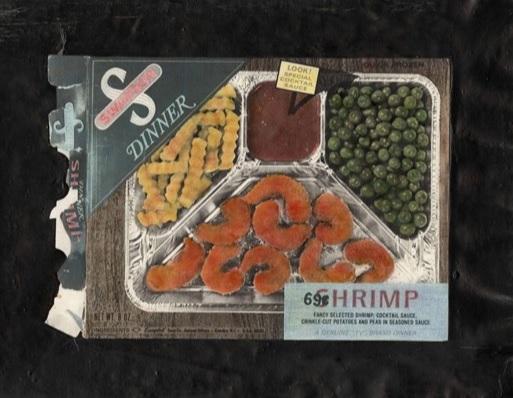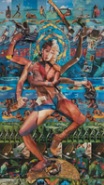
Robert Heinecken
American, 1931-2006
TV Dinner/Shrimp #1, 1971
unique emulsion on canvas with chalk
10 1/2 × 13 1/2 in.
SBMA, Museum Purchase
2008.49a

Robert Heinecken checking prints, 1982 (Photo: Bill Jay)
“An aspect of the work has to do with altering the literal/cultural meaning of existing public images by making minimal changes and additions. Using superimposition, juxtaposition and other contextual changes, I am functioning as a visual guerrilla.”
- Robert Heinecken

Shiva, The Lord Whose Half Is Woman, 1992
COMMENTS
Sex and food. They are the core requirements of human life, the paths to fundamental appetites that must be satisfied, the daily reminders of our physical nature, the great levelers that no individual can fully transcend. It is no surprise that sex and food, hunger zones so central to what comprises us, are also stupendously rich cultural foci: their representations, particularly by the media, are stunningly powerful sites of mass psychology and revelation, places where we expose hidden desires and manias. As a tribute to Robert Heinecken (1932-2006), Rod Slemmons, Director of Chicago’s Museum of Contemporary Photography, collected images from Heinecken’s restless engagements with these topics, surveying work from the 1960s through the 1990s.
Heinecken’s particular brilliance was well suited to these subjects. While his production did vary, it centered on some deconstructive and suggestive anthropological/sociological examinations of mainstream and commercial photography as a form of inexorable cultural confession, as a communicative means through which we inevitably and somewhat unconsciously expose our hopes and fears. For the most part, Heinecken photographed photographs, often from magazines, collaging them together, juxtaposing or superimposing one atop another, and his work provided a compelling argument that we live not so much in a physical world of nature and time as in some imagistic flux-realm, some meta-place where popular mass media effaces the real and constructs a hyper-zone of titillation and confession. Food first!
Heinecken’s "TV Dinner/Shrimp", 1971, is a series of six photographs that narrate a TV dinner from packaging to consumption. The first photograph shows the glossy seduction of display and advertising, as Heinecken photographed the boxed dinner with its alluring and heightened image of the promised luscious repast. The next several photographs chronicle the chastening reality of what is in the box, a lot of tin foil and some unappetizing chow that looks nowhere as desirable as what is shown on the box, but is nevertheless consumed bit by bit, until an empty tray completes the series. It is a mini-suite of expectation and denial: the packaging creates one level of seduction that is eventually frustrated, but consumed anyway, the tricky falling-off between the ideal and the real. Other images here deconstruct things such as hamburgers and meals from art-museum cafés in telling autopsies of the ubiquity of consumption.
If packaging and the presentation of food is no small part of an effort to stimulate desire, that becomes even more apparent in the relentless attempts to summon the erotics of sexuality. It is everywhere, and Heinecken’s work indulges in the ceaseless glut of sexualized imagery that is part of every aspect of modern culture. By juxtaposing or layering endless images of fashion, celebrity, advertising, and pornography, often accompanied by snippets of text, Heinecken offers human sexuality as having largely shifted from a physical to a visual activity. Images of bondage, fetishism, and oral fixation, of women as bearers of sexual attributes (and that is from the mainstream material!) pile up in endless combination, pandering to the heterosexual male viewer, the assumed consumer of much of Heinecken’s source material.
"Shiva, The Lord Whose Half Is Woman", 1992, made from literally hundreds of photographs, offers a kind of summary for Heinecken, a kind of ironic omnisexuality, a hermaphroditic tantra of sexuality that both celebrates and transcends gender and/or sexual orientation in some paean to pleasure as another consumer delight. When it came to sex, Heinecken always reckoned on the eye as the hungriest and most erotic orifice of all.
James Yood, “Robert Heinecken: Sex and Food”, Aperture Archive, Winter, 2007
https://archive.aperture.org/article/2007/4/4/robert-heinecken-sex-and-food
SBMA CURATORIAL LABELS
Referring to himself as a “para-photographer,” Robert Heinecken often worked without a camera and incorporated images from magazines, newspapers, catalogs, and commercial items into his work. In his TVDinner/Shrimp photographs, Heinecken visually narrates the gradual consumption of a Swanson TV dinner. Through the lure of product design, the package promises an alluring and delicious boxed meal; however, the subsequent photographs demonstrate the discrepant reality of the box’s pitiful contents and their underwhelming presentation. Wrapped in a copious amount of tinfoil, the actual dinner appears to consist of overheated shrimp, congealed sauce, and cardboard-looking fries and peas that presumably end up being consumed anyway. Through this series of photographs, Heinecken alludes to idealized expectations and the misleading reality of material goods marketed for mass consumption.
- Thinking and Seeing Beyond the Lens, 2023
